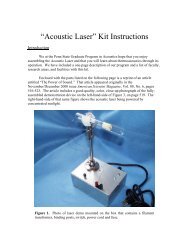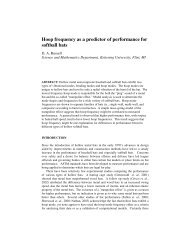Acoustic monopoles, dipoles, and quadrupoles
Acoustic monopoles, dipoles, and quadrupoles
Acoustic monopoles, dipoles, and quadrupoles
You also want an ePaper? Increase the reach of your titles
YUMPU automatically turns print PDFs into web optimized ePapers that Google loves.
IV. AUDIBLE DEMONSTRATION<br />
A comparison of the effectiveness of monopole, dipole,<br />
<strong>and</strong> quadrupole sources at radiating low frequencies may be<br />
demonstrated very effectively using the apparatus described<br />
in this paper. 5,13 The speakers were stacked in a square all<br />
facing the same direction as shown in Fig. 8, <strong>and</strong> music was<br />
played through them �the same signal went to all four speakers�.<br />
The polarity of individual speakers was reversed by the<br />
switch box. When the switches were set so that all four<br />
speakers had the same phase as in Fig. 8�a�, so that the<br />
speaker arrangement acted like a monopole, the low frequencies<br />
in the music were quite audible. Reversing the polarity<br />
of two adjacent speakers produced a dipole source as in Fig.<br />
8�b� <strong>and</strong> �c�. This caused the bass frequencies to be significantly<br />
reduced while the middle <strong>and</strong> high frequencies were<br />
relatively unaffected. Matching the polarity of diagonal<br />
speakers produced a quadrupole source as in Fig. 8�d�. Now<br />
the bass frequencies were severely impaired <strong>and</strong> midrange<br />
frequencies were also reduced. This very simple demonstration<br />
makes a big impression on students.<br />
Figure 9 shows 1/3-octave measurements of the sound<br />
pressure level when pink noise was played through the<br />
speaker stack. A sound level meter was placed a distance of<br />
1 m from the speakers <strong>and</strong> approximately aligned with the<br />
center of the square. Figure 9�a� compares the sound spectrum<br />
produced by monopole <strong>and</strong> dipole arrangements. The<br />
low frequencies are greatly reduced, with midfrequencies<br />
slightly reduced, <strong>and</strong> high frequencies largely unaffected.<br />
Figure 9�b� compares the sound spectrum produced by<br />
monopole <strong>and</strong> quadrupole arrangements. Now both low <strong>and</strong><br />
middle frequencies have been severely reduced.<br />
V. SUMMARY<br />
A simple <strong>and</strong> inexpensive experiment using four 4-in.<br />
boxed loudspeakers very effectively demonstrates the angular<br />
distribution of the sound field radiated by acoustic monopole,<br />
dipole, <strong>and</strong> quadrupole sources. At low frequencies,<br />
each boxed speaker acts as a simple source, radiating sound<br />
equally in all directions. To observe directivity patterns the<br />
four speakers are symmetrically arranged on a rotating stool<br />
<strong>and</strong> the sound field is measured with a sound level meter as<br />
the stool is rotated through 360°. A simple switch box enables<br />
the polarity of each speaker to be reversed, allowing<br />
students to drive the speakers together as a monopole, or in<br />
pairs as <strong>dipoles</strong> <strong>and</strong> <strong>quadrupoles</strong>. Measured directivity patterns<br />
agree very well with theoretical predictions. Stacking<br />
the speakers <strong>and</strong> playing music through them demonstrates<br />
the relative efficiency of <strong>monopoles</strong>, <strong>dipoles</strong>, <strong>and</strong> <strong>quadrupoles</strong><br />
at producing low frequency sounds.<br />
a�<br />
Formerly GMI Engineering & Management Institute.<br />
1<br />
A. D. Pierce, <strong>Acoustic</strong>s, An Introduction to its Physical Principles <strong>and</strong><br />
Applications �<strong>Acoustic</strong>al Society of America, New York, 1989�, pp. 159–<br />
171.<br />
2<br />
A. P. Dowling, ‘‘Steady-State Radiation From Sources,’’ in Encyclopedia<br />
of <strong>Acoustic</strong>s, edited by M. J. Crocker �Wiley, New York, 1997�, Chap. 9,<br />
pp. 107–125.<br />
3<br />
M. H. Nayfeh <strong>and</strong> M. K. Brussel, Electricity <strong>and</strong> Magnetism �Wiley, New<br />
York, 1985�, pp. 58–69.<br />
4<br />
J. B. Marion <strong>and</strong> M. A. Heald, Classical Electromagnetic Radiation �Harcourt<br />
Brace Jovanovich, New York, 1980�, pp. 34–48.<br />
5<br />
E. Meyer <strong>and</strong> E. G. Neumann, Physical <strong>and</strong> Applied <strong>Acoustic</strong>s: An Introduction<br />
�Academic, New York, 1972�, pp. 154–160.<br />
6<br />
D. A. Russell, ‘‘Measuring the Directivity of a Loudspeaker with <strong>and</strong><br />
without a Baffle,’’ available on the WWW at: http://www.kettering.edu/<br />
�drussell/anvlabs1.html.<br />
7<br />
L. L. Beranek, <strong>Acoustic</strong>s �<strong>Acoustic</strong>al Society of America, New York,<br />
1986�, pp. 91–115.<br />
8<br />
L. E. Kinsler, A. R. Frey, A. B. Coppens, <strong>and</strong> J. V. S<strong>and</strong>ers, Fundamentals<br />
of <strong>Acoustic</strong>s �Wiley, New York, 1982�, pp. 167–172.<br />
9<br />
M. P. Norton, Fundamentals of Noise <strong>and</strong> Vibration Analysis for Engineers<br />
�Cambridge U.P., Cambridge, 1989�, pp. 125–145.<br />
10<br />
D. D. Reynolds, Engineering Principles of <strong>Acoustic</strong>s: Noise <strong>and</strong> Vibration<br />
Control �Allyn <strong>and</strong> Bacon, Boston, 1981�, pp. 531–594.<br />
11<br />
Optimus XTS 40 loudspeakers �4-in., 150–18 000 Hz� are available from<br />
Radio Shack �catalog No. 40-1991�. They are quite often on sale for<br />
$14.99.<br />
12<br />
Digital Sound Level Meter 33-2055 is available from Radio Shack for<br />
$59.99. An analog meter 33-2050 is available for $29.99.<br />
13<br />
T. D. Rossing, <strong>Acoustic</strong>s Laboratory Experiments �Northern Illinois U.P.,<br />
DeKalb, IL, 1982�, Experiment 41: Monopole, Dipole, <strong>and</strong> Quadrupole<br />
Sources.<br />
PREMATURE DISCLOSURE<br />
I wrote four letters explaining what I wanted <strong>and</strong> asking for hospitality. ...Back did not reply;<br />
Cohnen said that his grating was at the moment out of commission, because his institute was being<br />
rebuilt; Paschen told me that he liked my idea, <strong>and</strong> that he had just put one of his doctoral<br />
c<strong>and</strong>idates to work on it. I was furious at this unexpected answer, but the project must have come<br />
to naught, because I never heard any further news of it. Zeeman, a Nobel Prize winner <strong>and</strong> the<br />
discoverer of the celebrated Zeeman effect, told me to catch a train <strong>and</strong> come to Holl<strong>and</strong>.<br />
Emilio Segrè, A Mind Always in Motion—The Autobiography of Emilio Segrè �University of California Press, Berkeley,<br />
1993�, pp. 65–66.<br />
664 Am. J. Phys., Vol. 67, No. 8, August 1999 Russell, Titlow, <strong>and</strong> Bemmen<br />
664








